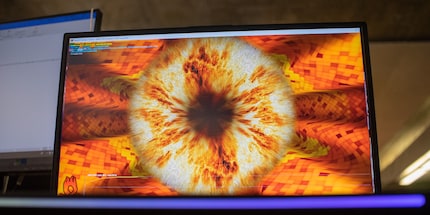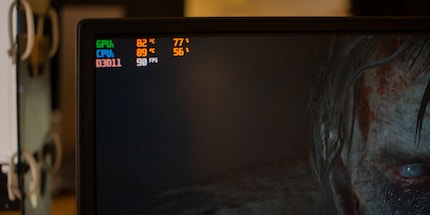
Product test
Rog Strix Scar II: maximum power at a reasonable price
by Kevin Hofer


In my review, I criticised the Asus Rog Strix Scar II for its heat development. I therefore subjected it to a long-term stress test. Not only did the notebook survive the test, but I was also impressed by the system stability.
Please excuse me, dear Asus Rog Strix Scar II, I have done you an injustice. I've stressed you out for over 200 hours with Fur Brand and HeavyLoad and you're still alive. I still think you're ugly, but your inner values are convincing. And that's what counts.
For the stress test, I run two programmes at the same time. Heavyload with the test methods "Utilise processor", "Reserve memory" and "Utilise GPU" as well as Fur Mark with standard settings in 1080p. This pushes the components to the limit.
First, I run the two programmes for four hours, switch off the notebook to cool down and start the stress test for another four hours. I do the whole thing 50 times, which results in a total runtime of 200 hours. I think four hours is a realistic length of time for the Scar II to run. Of course, Heavyload and Furmark - affectionately christened "Katzenanus" by the editorial team due to the great animation - put more strain on the device than some games do. This ensures that the Scar II doesn't falter even under the toughest gaming requirements.

After the 50 runs, I run the Fire Strike and Time Spy benchmarks. This allows me to check whether the performance has changed since the review.
After that, I continue with the long-term stress test. The ugly duckling has to endure five full days under continuous load. This is followed by Fire Strike and Time Spy.
The Scar II's performance is astonishing. It didn't crash once during the 50 tests. The CPU temperature is between 85 and 92 degrees Celsius. The GPU temperature is between 84 and 90 °C. I have an artefact once, but it disappears again after a restart. Otherwise, I can't report anything worth mentioning. The device runs stably and I don't give any smoke signals.
After the stress test, it's time to benchmark. The results make me sit up and take notice. The Scar scores 7195 points in Time Spy. That's 243 points more than last time. The notebook also achieved a higher score in Fire Strike - 16,735 compared to 16,279. I wondered how this was possible and contacted my colleague Philipp Rüegg to see if he had any ideas.
He does, and he has an explanation. He needed the notebook for his "digitec plays" and updated the drivers. Thank you Philipp for manipulating my test result. Anyway, the interim conclusion is that the Scar II runs stably and the high intensity of use does not impair performance.
Now it's time to get down to business. The Scar II is supposed to run for 120 hours at a time. Hopefully I won't burn down our company headquarters. Although, by now I'm so confident in its performance that I'm not too worried. I wouldn't be surprised if the notebook ran for five days straight.
I start the test on Monday morning. When I go home in the evening, everything is still working perfectly. Unfortunately, as I only work 80 per cent and have Tuesday off, I can't monitor the progress of the test throughout. When I get to the office on Wednesday, I find the Scar II closed. Who the hell switched it off?
Now I have to start all over again. Annoyed, I try to start Fur Mark again. I get an error message saying that the graphics card does not meet the requirements. A look at the device manager reveals error 43 for the RTX 2070. I update the driver and restart Windows. Error 43 has now disappeared and I can restart the test.
My stress tests caused the Scar II to crash after all and provoked a problem with the driver. I'm already a little disappointed. I actually thought it would hold out. Anyway, maybe it'll work the second time. Everyone deserves a second chance.
The second time round, Fur Mark and Heavyload bring the Scar II to its knees again. After an estimated eleven hours, it's over. Colleague Martin Jud is still in the office at the time of the crash. He sees an error message but can no longer read it before the display goes black. The Scar II has also blown its second chance.
I want to find out what caused the crash. To do this, I open the Windows 10 Event Viewer, where the operating system logs crashes, error messages and warnings. Interestingly, Windows does not register the crash. The last logged event on 3 April at 17:25:13 is information about a quality assurance check. If I go back a little further, I notice that the event display starts to show errors and warnings at around a quarter to five. These mainly concern the unsuccessful execution of applications or that there is not enough virtual memory available.
Heavyload and Fur Mark really brought the Scar II to its knees. I look at the event viewer to see if I can find a similar pattern in my first test. In fact, the error messages and warnings also accumulated here around the assumed time of the crash. Not to the same extent as the second test, but I can still recognise a pattern.
This pattern makes me realise that I can forget the five days and five nights of continuous stress testing. The Scar II won't be able to do that. At some point, the system is overwhelmed and shuts down on its own. Basically a good self-protection mechanism, but a shame for my test.
Despite the failed test, I run the benchmarks again. Maybe the hardware suffered before the crash. I am proven wrong. The Scar II scores 7213 points in Time Spy and 876 in Fire Strike 16, which are again higher scores than last time. I had to reinstall the driver after the crash, and a newer version than before. I blame the driver update for the better results.
In total, I subjected the Scar to the stress tests for just over 220 hours. I would have liked to have added 100 hours with the long-term stress test. I would have been delighted if the Scar II had lasted the five days and five nights. In the meantime, I've grown fond of it, especially because of Fur Brand aka Katzenanus, who has been my constant companion over the past few weeks.
It's a shame that it didn't work out with the 120 hours in a row, but I still consider the test result a success. The goal of Heavyload and Fur Mark is to stress the system so much that it crashes. The fact that this crash only occurs after more than eleven hours is not a matter of course. Many of the notebooks we tested here on the digitec editorial team didn't make it that long.
The high temperatures did not diminish the performance of the device. Of course, 220 hours is not an eternity. As an active gamer, you will quickly use the Scar II for that long. Nevertheless, the stress test gives a good indication. In all the hours of testing, I wasn't able to make any smoke signals with the Scar II. The probability that this will be the case in another 200, 400 or 1000 hours is very low. In addition, I couldn't detect any thermal throttling during my review and after the stress tests while gaming. Not even at 90 degrees Celsius.

I take back my criticism of the Scar II: If you like loud fans and don't play with the gaming notebook on your thighs, the Scar II runs very stable despite high temperatures - and for many hundreds of hours.


From big data to big brother, Cyborgs to Sci-Fi. All aspects of technology and society fascinate me.